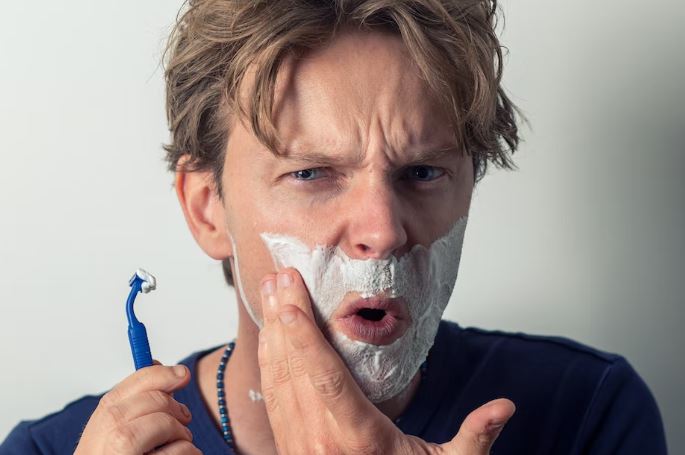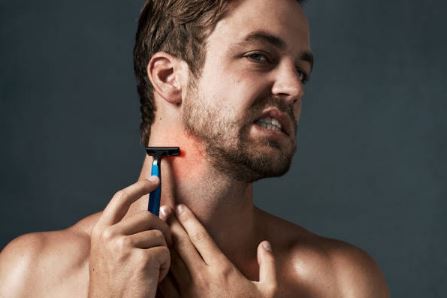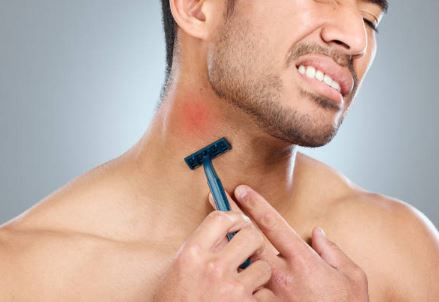
When you have razor burn, the damage takes three to four days to heal. Your method of care will determine how long it takes for your razor burn to heal. A razor burn usually takes three days to heal completely when left alone. Keep the skin moisturized to aid in a speedy recovery from symptoms. Continue reading, you will learn how to treat razor burn and prevent it.
Table of Contents
How Long Does Razor Burn Last?
A very common condition that can last anywhere from a few hours to a few days is razor burn. Without any treatment, it typically gets better on its own. Avoid shaving the affected area until it clears up to hasten to heal.
What is Razor Burn?
A couple of hours after shaving, razor burn develops. It can be caused by:
- using an old razor
- shaving too quickly
- shaving in the wrong direction
- shaving over skin that’s dry
Razor burn symptoms include:
- itching
- redness
- flaking
Razor burn symptoms may begin to go away in a few hours, but it may take them two or three days to completely go away. Keep the skin moisturized to aid in a speedy recovery from symptoms.
What Are Razor Bumps?
Ingrown hairs are caused by shaving and appear as razor bumps.
Hair strands that curl inward and grow back into your skin when hair grows back in a shaved area can result in red, itchy bumps that may or may not contain pus. When hair is coarse or tightly coiled, it is more likely to curl inward, making it more prevalent in those people.
Razor bumps may not appear for several days after shaving, in contrast to razor burn, which does. They also take longer to go away and, in some instances, can leave scars.
Within two to three weeks of shaving, razor bumps usually go away on their own. Some individuals, though, experience them after every shave. This results in a cycle of shaving, razor bumps, and subsequent healing. The bumps appear once more after reshaving the area.
How Can I Tell the Difference Between Razor Burn and Herpes?
A blotchy red skin rash is brought on by razor burn. Small, rosy razor bumps could be brought on by ingrown hairs. Your vaginal area may experience razor burn or razor bumps, but they usually go away on their own in a few days.
Near your penis or vagina, herpes simplex viruses can cause bumps that resemble fluid-filled sores or blisters. They form groups as they grow. The presence of a fever and a headache could be additional symptoms. Herpes bumps may also disappear on their own, but they frequently return.
Consult your doctor if you’re unsure whether you have harmless razor bumps or a more serious condition like herpes.
Who Does Razor Burn Affect?
Anyone who shaves their body to remove unwanted hair risks developing razor burn. People with acne are slightly more likely to have the condition. Razor burn may happen to you more frequently if you have sensitive skin.
In Black people who were assigned as male at birth (AMAB), razor bumps are more prevalent. Up to 83% of Black AMAB people may have razor bumps.

What Causes Razor Burn?
When you use a razor, your skin, hair, and hair growth all interact with the blade, causing razor burn. A blade moving across your skin can cause minute cracks in the epidermis, as well as a loss of moisture and inflammation. Other common causes of razor burn may include:
- Dry shaving is shaving without the use of water, soap, shaving cream, or shaving gel.
- Shaving too fast.
- using an old, dull razor blade to shave.
- shaving in the opposite direction of the hair’s growth.
- using products that irritate your skin or have sensitive skin.
What Does Razor Burn Look Like?
Razor burn appears as a streaky red rash or a red, irritated patch of skin. Other symptoms of razor burn may include:
- Pain or discomfort.
- the sensation of burning or stinging.
- Itchiness.
- swelling and sensitivity.
What Are the Treatments for Razor Burn?
Usually, razor bumps and burns go away on their own and don’t need to be treated. But the following tips may help relieve symptoms and support the healing process:
- To relieve burning and itching, apply a cold compress.
- Aloe vera gel can be used to reduce inflammation.
- Use the natural astringent witch hazel to reduce inflammation.
- To relieve itchiness, apply a moisturizer without fragrance.
- To get rid of itching, soak in an oatmeal bath.
For relief from itching and inflammation, you can also try using over-the-counter hydrocortisone creams.
How is Razor Burn Diagnosed?
You can most likely self-diagnose razor burn if you experience a red, blotchy skin rash following shaving. Call your healthcare provider if the rash doesn’t go away on its own after a couple of days. They can aid in the analysis and treatment of your illness.
What Are the Tips for Shaving?
You can reduce your chances of experiencing razor burn or razor bumps by keeping the following in mind next time you shave:
- Always use a loofah, washcloth, or mild body scrub to exfoliate before shaving.
- To soften hair and remove any embedded hairs, soak your skin in warm water or steam for a few minutes prior to shaving.
- In order to prevent ingrown hairs, try to keep hair at least 0.5 millimeters long. Try to shave every day using gentle strokes if you prefer to keep your beard uncut.
- Use a conditioner, shaving cream, or body oil on your skin before shaving, and never do a dry shave.
- When shaving, avoid pulling your skin taut.
- As you shave, remember which way your hair grows.
- Replace razors on a regular basis. A disposable razor typically lasts for two to three weeks or 10 shaves.
- For several hours following shaving, use sunscreen on newly shaved skin or stay out of the sun entirely.
Consider switching to an electric trimmer if you frequently get razor bumps. Some people discover that these cause fewer razor bumps than razors.
When to See a Doctor?
While you can usually manage razor burn and razor bumps on your own, you’ll want to talk with a healthcare professional if you notice:
- sweet-smelling pus coming out of razor bumps
- non-stop bleeding from razor burn or razor bumps
- razor bumps that aren’t healing after a couple of weeks
These signs could be an indication that you have something other than razor bumps or burns, such as pustular psoriasis or tinea barbae.

If you frequently experience razor burns or bumps, you might want to consult a dermatologist. You might be more susceptible to folliculitis because of sensitive skin or hair.
If so, they might suggest a topical medication to lessen inflammation. These might include:
- retinoids
- antibiotics
- steroids
- benzoyl peroxide
How Can I Prevent Razor Burn?
Make sure your skin is soft and moist prior to shaving to prevent razor burn. You might want to shave as soon as possible after taking a shower so that your skin is free of dead skin cells and extra oil that could clog your razor blade. To further protect your skin from the razor blade, use a lubricant like soap, shaving cream, or shaving gel. Additionally, it will make it easier for the blade to pass through your skin. Other tips to prevent razor burn include:
- Shave in the direction of your hair growth: Inflammation may result from shaving in the opposite direction of hair growth.
- Use light, short strokes: Avoid shaving over the same area more than once, and avoid shaving too quickly.
- Clean your razor blade often: Rinse your razor after every few strokes to get rid of the hair and soap that has built up in the space between the blades.
- Rinse your skin: Following a shave, rinse your face with cold water or pat your skin dry with a damp washcloth.
- Moisturize your skin: After shaving, apply a hydrating lotion or gel to help calm and repair the barriers in your skin. Products with fragrances or other skin irritants should be avoided.
- Store your razor in a dry place: To stop bacteria from growing, clean, dry, and then store your razor in a dry location.
- Replace your razor blade frequently: Always keep your razor blades sharp and rust-free. After five to seven uses, throw the razor blade away.
- Avoid tight clothing: Wear loose-fitting clothing or underwear after shaving. By doing this, skin irritation can be avoided.
Waxing might be a better option if you frequently get razor burn. This could lessen the chance of recurrent skin irritation.
What Complications Can Occur Due to Razor Burn?
Razor burn is a very common condition that typically goes away on its own. Another condition that can develop as a result of shaving is razor bumps. Pseudofolliculitis barbae is a form of folliculitis that can be brought on by ingrown hairs. Folliculitis develops when an inflamed or infected hair follicle occurs.
People with curly hair and Black people who are born male are more likely to develop pseudofolliculitis barbae. Your neck and beard are typically where the condition manifests itself. Your beard or neck hair will become pointy and spear-like after shaving. These tiny spears have the ability to reverse direction and pierce your skin. Your skin may become irritated, and bumps that resemble pimples may develop. Similar approaches can be used to treat razor burn and pseudofolliculitis barbae. However, serious conditions might need your healthcare provider’s attention.
What’s the Longest Razor Burn Can Last?
Razor burn and its symptoms last up to a few hours, while moderate cases can last up to 2-3 days with proper treatment. However, if you leave it be, razor burns can cause severe irritation with bumps or folliculitis, of which can take at least 2 weeks to heal.
Does Razor Burn Go Away by Itself?
The majority of the time, it will go away on its own, but you can take some actions to hasten skin healing and avert further incidents. You should apply calming products that also shield the skin and keep it moisturized to relieve uncomfortable razor burns and hasten the healing process.

How Do You Get Rid of Razor Burn Very Fast?
Your skin will be soothed, moisturized, and healed at the same time thanks to aloe vera. Home remedies such as apple cider vinegar, witch hazel extract, or tea tree oil mixed with water can help stop inflammation from razor burn. You can also apply an over-the-counter (OTC) hydrocortisone cream or take an oatmeal bath.
Conclusion
Razor burn usually goes away in two to three days. Razor bumps, on the other hand, may take up to two weeks to go away and may reappear after each shave.
Consult a healthcare provider to rule out any additional causes of your symptoms if they don’t go away within a few weeks, and/or look into prescription medication.